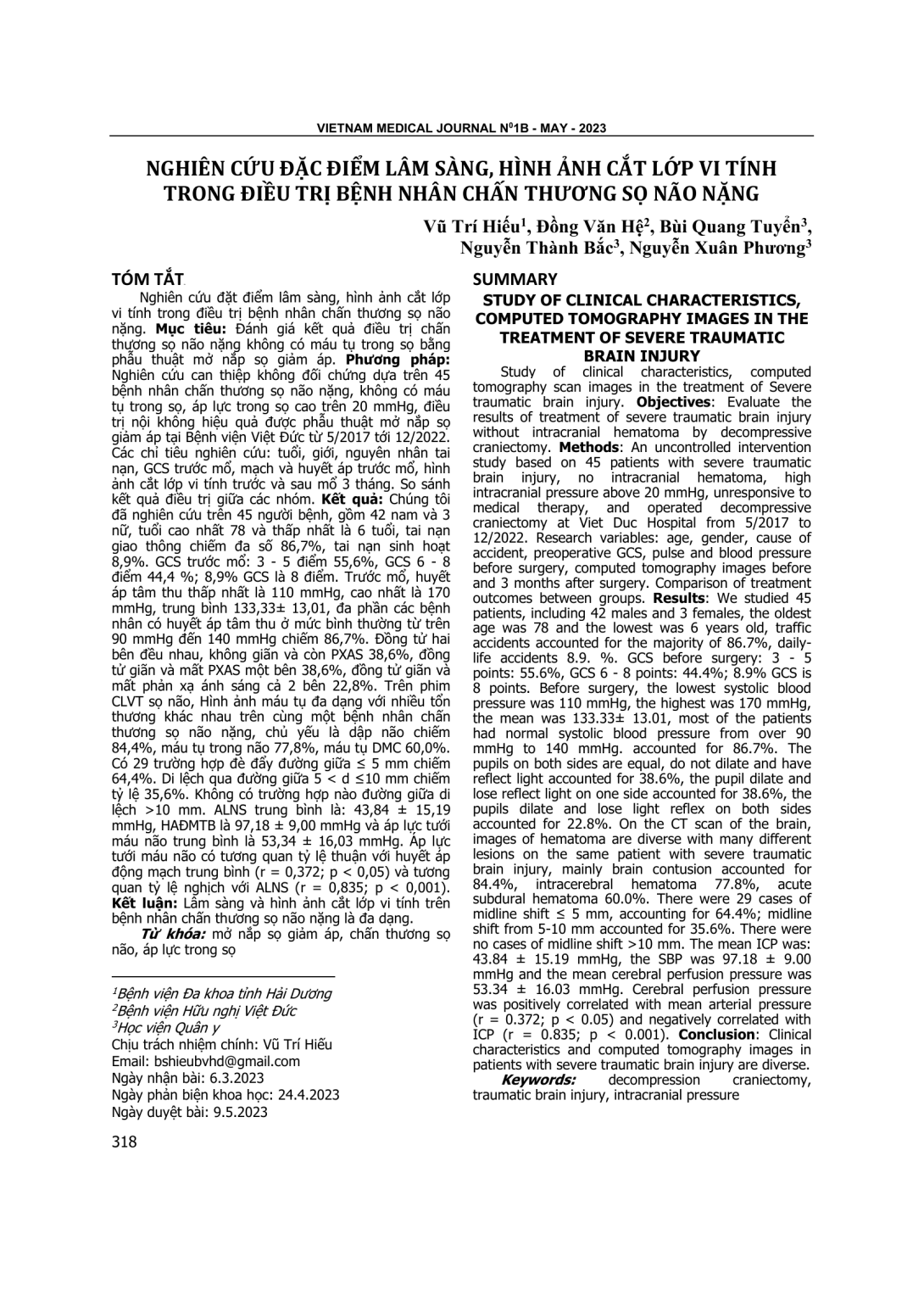
Đánh giá kết quả điều trị chấn thương sọ não nặng không có máu tụ trong sọ bằng phẫu thuật mở nắp sọ giảm áp. Phương pháp: Nghiên cứu can thiệp không đối chứng dựa trên 45 bệnh nhân chấn thương sọ não nặng, không có máu tụ trong sọ, áp lực trong sọ cao trên 20 mmHg, điều trị nội không hiệu quả được phẫu thuật mở nắp sọ giảm áp tại Bệnh viện Việt Đức từ 5/2017 tới 12/2022. Các chỉ tiêu nghiên cứu: tuổi, giới, nguyên nhân tai nạn, GCS trước mổ, mạch và huyết áp trước mổ, hình ảnh cắt lớp vi tính trước và sau mổ 3 tháng. So sánh kết quả điều trị giữa các nhóm. Kết quả: Chúng tôi đã nghiên cứu trên 45 người bệnh, gồm 42 nam và 3 nữ, tuổi cao nhất 78 và thấp nhất là 6 tuổi, tai nạn giao thông chiếm đa số 86,7%, tai nạn sinh hoạt 8,9%. GCS trước mổ: 3 - 5 điểm 55,6%, GCS 6 - 8 điểm 44,4 %; 8,9% GCS là 8 điểm. Trước mổ, huyết áp tâm thu thấp nhất là 110 mmHg, cao nhất là 170 mmHg, trung bình 133,33± 13,01, đa phần các bệnh nhân có huyết áp tâm thu ở mức bình thường từ trên 90 mmHg đến 140 mmHg chiếm 86,7%. Đồng tử hai bên đều nhau, không giãn và còn PXAS 38,6%, đồng tử giãn và mất PXAS một bên 38,6%, đồng tử giãn và mất phản xạ ánh sáng cả 2 bên 22,8%. Trên phim CLVT sọ não, Hình ảnh máu tụ đa dạng với nhiều tổn thương khác nhau trên cùng một bệnh nhân chấn thương sọ não nặng, chủ yếu là dập não chiếm 84,4%, máu tụ trong não 77,8%, máu tụ DMC 60,0%. Có 29 trường hợp đè đẩy đường giữa ≤ 5 mm chiếm 64,4%. Di lệch qua đường giữa 5 < d ≤10 mm chiếm tỷ lệ 35,6%. Không có trường hợp nào đường giữa di lệch >10 mm. ALNS trung bình là: 43,84 ± 15,19 mmHg, HAĐMTB là 97,18 ± 9,00 mmHg và áp lực tưới máu não trung bình là 53,34 ± 16,03 mmHg. Áp lực tưới máu não có tương quan tỷ lệ thuận với huyết áp động mạch trung bình (r = 0,372; p < 0,05) và tương quan tỷ lệ nghịch với ALNS (r = 0,835; p < 0,001). Kết luận: Lâm sàng và hình ảnh cắt lớp vi tính trên bệnh nhân chấn thương sọ não nặng là đa dạng.
Evaluate the results of treatment of severe traumatic brain injury without intracranial hematoma by decompressive craniectomy. Methods: An uncontrolled intervention study based on 45 patients with severe traumatic brain injury, no intracranial hematoma, high intracranial pressure above 20 mmHg, unresponsive to medical therapy, and operated decompressive craniectomy at Viet Duc Hospital from 5/2017 to 12/2022. Research variables: age, gender, cause of accident, preoperative GCS, pulse and blood pressure before surgery, computed tomography images before and 3 months after surgery. Comparison of treatment outcomes between groups. Results: We studied 45 patients, including 42 males and 3 females, the oldest age was 78 and the lowest was 6 years old, traffic accidents accounted for the majority of 86.7%, daily-life accidents 8.9. %. GCS before surgery: 3 - 5 points: 55.6%, GCS 6 - 8 points: 44.4%; 8.9% GCS is 8 points. Before surgery, the lowest systolic blood pressure was 110 mmHg, the highest was 170 mmHg, the mean was 133.33± 13.01, most of the patients had normal systolic blood pressure from over 90 mmHg to 140 mmHg. accounted for 86.7%. The pupils on both sides are equal, do not dilate and have reflect light accounted for 38.6%, the pupil dilate and lose reflect light on one side accounted for 38.6%, the pupils dilate and lose light reflex on both sides accounted for 22.8%. On the CT scan of the brain, images of hematoma are diverse with many different lesions on the same patient with severe traumatic brain injury, mainly brain contusion accounted for 84.4%, intracerebral hematoma 77.8%, acute subdural hematoma 60.0%. There were 29 cases of midline shift ≤ 5 mm, accounting for 64.4%; midline shift from 5-10 mm accounted for 35.6%. There were no cases of midline shift >10 mm. The mean ICP was: 43.84 ± 15.19 mmHg, the SBP was 97.18 ± 9.00 mmHg and the mean cerebral perfusion pressure was 53.34 ± 16.03 mmHg. Cerebral perfusion pressure was positively correlated with mean arterial pressure (r = 0.372; p < 0.05) and negatively correlated with ICP (r = 0.835; p < 0.001). Conclusion: Clinical characteristics and computed tomography images in patients with severe traumatic brain injury are diverse.
- Đăng nhập để gửi ý kiến
